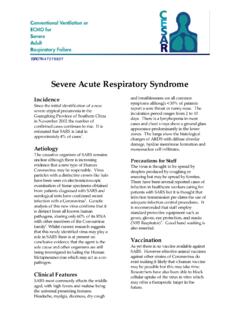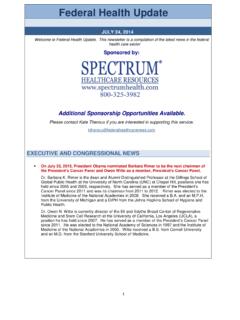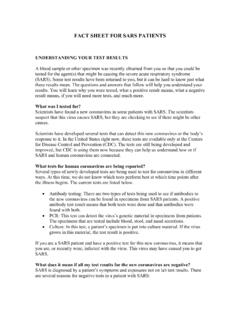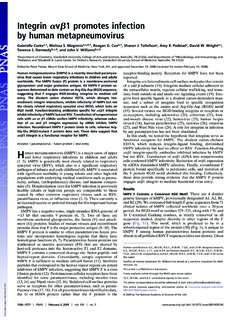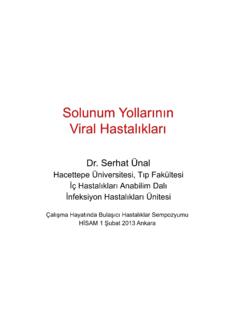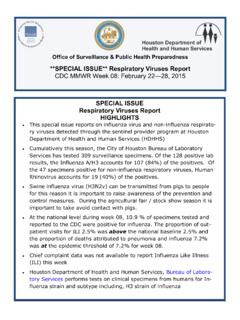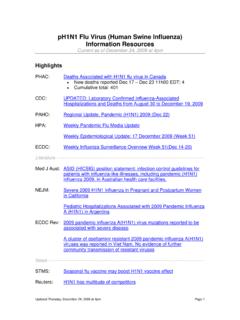Transcription of Rational Design of Human Metapneumovirus Live Attenuated ...
1 Rational Design of Human Metapneumovirus live Attenuated VaccineCandidates by Inhibiting Viral mRNA Cap MethyltransferaseYu Zhang,a,bYongwei Wei,aXiaodong Zhang,aHui Cai,aStefan Niewiesk,aJianrong LiaDepartment of Veterinary Biosciences, College of Veterinary Medicine,aand Program in Food Science and Technology,bThe Ohio State University, Columbus, Ohio, USAABSTRACTThe paramyxoviruses Human respiratory syncytial virus (hRSV), Human Metapneumovirus (hMPV), and Human parainfluenzavirus type 3 (hPIV3) are responsible for the majority of pediatric respiratory diseases and inflict significant economic loss, healthcare costs, and emotional burdens. Despite major efforts, there are no vaccines available for these viruses. The conserved regionVI (CR VI) of the large (L) polymerase proteins of paramyxoviruses catalyzes methyltransferase (MTase) activities that typicallymethylate viral mRNAs at positions guanine N-7 (G-N-7) and ribose 2=-O.
2 In this study, we generated a panel of recombinanthMPVs carrying mutations in theS-adenosylmethionine (SAM) binding site in CR VI of L protein. These recombinant viruseswere specifically defective in ribose 2=-O methylation but not G-N-7 methylation and were genetically stable and highly attenu-ated in cell culture and viral replication in the upper and lower respiratory tracts of cotton rats. Importantly, vaccination of cot-ton rats with these recombinant hMPVs (rhMPVs) with defective MTases triggered a high level of neutralizing antibody, and therats were completely protected from challenge with wild-type rhMPV. Collectively, our results indicate that (i) amino acid resi-dues in the SAM binding site in the hMPV L protein are essential for 2=-O methylation and (ii) inhibition of mRNA cap MTasecan serve as a novel target to rationally Design live Attenuated vaccines for hMPV and perhaps other paramyxoviruses, such ashRSV and paramyxoviruses, including hRSV, hMPV, and hPIV3, cause the majority of acute upper and lower respiratory tract in-fections in humans, particularly in infants, children, the elderly, and immunocompromised individuals.
3 Currently, there is nolicensed vaccine available. A formalin-inactivated vaccine is not suitable for these viruses because it causes enhanced lung dam-age upon reinfection with the same virus. A live Attenuated vaccine is the most promising vaccine strategy for Human paramyxo-viruses. However, it remains a challenge to identify an Attenuated virus strain that has an optimal balance between attenuationand immunogenicity. Using reverse genetics, we generated a panel of recombinant hMPVs that were specifically defective in ri-bose 2=-O methyltransferase (MTase) but not G-N-7 MTase. These MTase-defective hMPVs were genetically stable and suffi-ciently Attenuated but retained high immunogenicity. This work highlights a critical role of 2=-O MTase in paramyxovirus repli-cation and pathogenesis and a new avenue for the development of safe and efficacious live Attenuated vaccines for hMPV andother Human Metapneumovirus (hMPV) is a relatively new humanpathogenthat was first described in 2001 in the Netherlands.
4 Itwas isolated from infants and children experiencing respiratory tractinfections with symptoms similar to those of infections caused byhuman respiratory syncytial virus (hRSV) (1). Since its discovery in2001,hMPV has been recognized worldwide to be one of the leadingcauses of lower respiratory infections, second only to hRSV (2,3).hMPVinfections are observed in all age groups, with a high preva-lence and severity among infants, children, the elderly, and immuno-compromised patients (2,3). Clinical symptoms associated withhMPVinfection are similar to those caused by hRSV infection andrange from asymptomatic infection to severe bronchiolitis and pneu-monia. hMPV is a nonsegmented negative-sense (NNS) RNA virusbelonging to the familyParamyxoviridae, the subfamilyPneumo-virinae, and the genusMetapneumovirus(1).
5 There are at least twolineagesof hMPV circulating in Human populations. These aredesignated A and B, which can be further divided into A1, A2, B1,and B2 on the basis of their surface glycoproteins and antigenicity(4,5). The only other member in the genusMetapneumovirusisavianmetapneumovir us (aMPV), also known as avian pneumo-virus or turkey rhinotracheitis virus, which causes respiratory dis-eases in turkeys (6,7).Despitemajor efforts, no vaccines or antiviral drugs with ac-tivity against hMPV are available. Generally, the two most com-mon strategies used in vaccine development are inactivated andlive Attenuated vaccines. For safety reasons, an inactivated vaccineis often preferred. However, inactivated vaccines developed forhuman paramyxoviruses have resulted in serious complicationswhen tested in Human clinical trials.
6 In the early 1960s, not onlydid the vaccination of infants with a formalin-inactivated (FI)RSV vaccine fail to protect the recipients against RSV disease dur-ing the following RSV season, but also many of the vaccine recip-ients developed enhanced disease upon infection with RSV, re-sulting in increased rates of severe pneumonia and two deaths (8).Enhancedlung damage was also observed when an FI vaccine forReceived27 March 2014 Accepted14 July 2014 Published ahead of print23 July 2014 Editor:D. S. LylesAddress correspondence to Jianrong Li, 2014, American Society for Microbiology. All Rights 2014 Volume 88 Number 19 Journal of Virology p. 11411 on December 22, 2020 by from Human parainfluenza virus type 3 (PIV3), another important hu-man paramyxovirus, was used (9).
7 In 2007, Yim et al. reportedthatan FI hMPV vaccine induced virus-specific immune re-sponses but resulted in enhanced lung damage upon reinfection incotton rats (10), similar to what had been previously described inthehRSV clinical trial. These results demonstrate that an FI vac-cine is not advised for hMPV, RSV, or PIV3, all of which can causeserious respiratory tract infections in the same populations,namely, infants, children, the elderly, and the Attenuated vaccines are the most promising vaccine can-didates against Human paramyxoviruses, since enhanced lungdamage has not been observed in animal models or Human clinicaltrials (11). Importantly, live Attenuated vaccines are capable ofinducingrobust and prolonged immune responses since theymimic a natural virus infection.
8 Soon after the discovery of hMPV,cold-passaged (cp) and temperature-sensitive (ts) hMPV strainswere isolated by randomly passing the virus in cell culture at re-duced temperatures (12). ThesecpandtshMPVsshowed attenu-ation in replication in the upper and lower respiratory tracts andinduced protection against challenge with hMPV strains (12). Re-cently,a reverse genetics system that has made manipulation ofthe hMPV genome possible has been developed (13,14). A varietyofrecombinant hMPVs have been generated by deleting nones-sential genes, such as the G, SH, M2-1, and M2-2 genes (15 19). Inaddition,chimeric hMPV and aMPV isolates were also success-fully recovered from molecular clones (20). However, it has beenachallenge to identify an hMPV vaccine strain that has a satisfac-tory balance between attenuation and immunogenicity.
9 Recom-binant hMPV (rhMPV) with a G-gene deletion (rhMPV- G)demonstrates reduced immunogenicity because G protein is oneof the major surface glycoproteins and plays an important role inmodulating the innate immune response (16,17,21). rhMPV withanSH gene deletion (rhMPV- SH) was not sufficiently attenu-ated in an animal model (17). rhMPV with a an M2-1 gene dele-tion(rhMPV- M2-1) was highly attenuatedin vivo, but it was notable to trigger a neutralizing antibody response or protective im-munity in animal models (19). The only Attenuated hMPV cur-rentlyin phase I Human clinical trials is a chimeric rhMPV inwhich the P gene is derived from aMPV (20). The genetic stability,safety,and immunogenicity of these vaccine candidates in hu-mans are currently not all other NNS RNA viruses, hMPV produces capped,methylated, and polyadenylated mRNAs (reviewed in reference22).
10 Recent evidence suggests that the mRNA capping and meth-ylationin NNS RNA viruses have evolved a mechanism that isdistinct to their hosts. Using vesicular stomatitis virus (VSV), aprototypical NNS RNA virus, as a model, it was found that cap-ping of VSV mRNA is achieved by a novel polyribonucelotidyl-transferase (PRNTase), located in CR V of the large (L) polymer-ase protein (Fig. 1A), which transfers a monophosphate RNA ontoaGDP acceptor through a covalent L-protein RNA intermediate(23 25). In contrast, cellular mRNA capping is catalyzed by anRNAguanylyltransferase (GTase) that reacts with GTP to form acovalent enzyme-GMP intermediate and transfers GMP todiphosphate RNA via a 5=-5=triphosphate linkage (26). In addi-tion,mRNA cap methylation in NNS RNA viruses is also unique,in that both guanine N-7 (G-N-7) and ribose 2=-O (2=-O) meth-yltransferase (MTase) activities are catalyzed by a single peptide,CR VI, within the L protein (Fig.)

